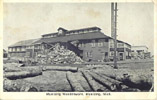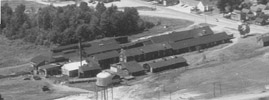
Munising Wood Products
Information and links related to the Munising Wood Products
factory that operated in Munising, Michigan from 1911 to 1955.

Interview: Paul Erickson, May 1983
interviewed by Charlie Symon, (Used with permission of Paul Erickson, 2001)
Paul's father, Elmer O. Erickson began work at the Munising Woodenware Company in 1911 as a stenographer. Milton Bonz, the owner at the time, could not read or write, Elmer recalled. Elmer was from Munising and had graduated from Munising High School in 1907. He worked a short time for the paper mill, then started at the woodenware plant. He worked his way up the office ladder, where a dozen or more men worked, to bookkeeper, accountant and finally was named office manager. Elmer took J. S. Anderson's place - a man whose shoes he had shined as a bellhop at the Beach Inn while Elmer had been in high school.
Paul said the first thing his father did after arriving (on foot) at work each day as manager was to take a walking inspection of the grounds. "He just about had to, there were no telephones or other communication." An office boy or two could be sent on errands during the day, but there was no substitute for the first hand information Erickson could get direct from the superintendent and the department heads. Also the last thing he did before going home at night was to repeat this round of inspection.
Elmer and Lester Shaffstall were very close friends, Paul remembers. Henry Johnson, too, was a close friend and coworker.
As manager, Elmer reported directly to Cleveland. His strong point was accounting and money management. He was often working seven days a week at the mill and was very efficient, Paul said.
Every Saturday, whenever possible, Paul's dad took him down to the woodenware. The young man's favorite place to stop and watch was the huge bandsaw. It was huge, and noisy, Paul said. it was fascinating the way things hummed at the woodenware. None of the machines had its own motor, but they all ran on a big drive shaft from above that drove the belts. The combination of the smell of freshly cut wood, the hum and bustle of friendly people and the warm, steam heated rooms made the woodenware plant "a comforting place to visit" Paul recalled.
In the clothespin department, Paul was also impressed by the enormous waxing tumbler. It was a cylinder 30 feet long by 10 or 12 feet high driven by belts and filled with clothespins. A big square of wax, two feet square, was also put in and the whole thing tumbled until the pins were coated. "They came out so clean mothers would give them to babies for teething," Paul said.
The only time the mill ran on Sunday was when a special order had to be filled. And there was always someone in the power house. The live steam heated the buildings on Sundays.
Elmer Erickson, as manager, became a member of the Birch Club, and organization of brokers of wood, choice logs and veneer logs. They bought and sold the logs to big furniture manufacturing companies, for instance in Grand Rapids there was a big one.
In this connection, Elmer had access to choice logs, which he would have sent down to Grand Rapids and made into custom pieces of furniture which his wife Hildur liked, mostly maple. Paul and his sister still have a captain's chair, Duncan Phyfe table, book case and wing back chair made in this way. The family also has a complete set of dishes and cups, etc. with the family "E" burned into the edges made of birdseye maple.
As for the strike of 1937, Elmer was manager at the time. One issue of that strike was the piecework vs. wages dispute, a sore point with workers who didn't work as fast, or who worked in departments where piece work pay wasn't offered. People like Louella Bressler, one of the very fastest pieceworkers in the mill, made a lot more money than others. She also got her base pay, but bettered herself immensely by her quickness. Paul thinks many workers were jealous of this. Of course, he said, the company liked the fastest, most efficient workers and paid accordingly.... incentive. Another issue was that there was no workmen's compensation insurance. If someone lost a finger the watchman went around and took up a collection for you, then you were on your own. The company paid the doctor bill, too, as Paul recalled. But after that, you couldn't work. Some safety regulation was needed too, it seemed. There were no guards on the saws or equipment.
Paul remembered the woodenware grounds stretching all the way from the highway M-28 down the hill the the back of the Vacationer Motel (in 1983). (This motel was moved in 1992 to make way for a Glen's supermarket and mini-mall to be built in 1993.) There were sometimes logs decked in the yard for a year's supply. A big steam-heated barn was provided for the company teams. Horses did all the work in the yard until 1940 (This date was confirmed by Bill Boucha). Then the company got a tractor to skid and haul. Trucks could only get in and out of the woods seasonally, whereas horses worked year round loading railroad cars. Also, one flat car of logs held as much as four truckloads. In 1932, the company bought a brand new Ford model B truck to haul rough wood in, Paul said. In 1937, it invested in a flat-bed stake truck to take away finished products. Otherwise, all else was done by rail.
Birch, beech and maple were the main woods used at the woodenware, Paul said. The hot pond was for getting the dirt out of the wood. As for accidents, Paul only remembered one man amputating some fingers on a band saw, and a couple men who fell in the hot pond, but other than these, it was smooth. No one died from falling in the Woodenware hot pond. It was the veneer pond that was boiling hot and killed Spike Pangborn.
Paul said Elmer worked in sales and shipping to some extent. Everything was sold by boxcar, wholesale. Erickson went to Grand Rapids often to handle the biggest accounts personally - choice logs for furniture, etc.
Robin Hood decorators was one big customer in the Los Angeles area, Paul said. They ordered plain bowls and then decorated them. The Erickson family had one from there that had a tomato and an onion on it, strolling hand in hand, and the tomato was crying big tears, Paul remembered.
Most lumber accounts were in Michigan, Paul thought. He said that made sense, because any further and the freight costs ate up profits. The buyers would also come to Munising to place their orders.
Elmer finally left the woodenware plant after several things combined to make him tired of it and ready to leave, Paul said. First, his wife died. Then, the strike was unpleasant. When the Depression wound down, the company changed policy and management in the main office in Piqua (Cleveland) Ohio, and asked Elmer to accept an assistant managership. He felt no particular grudge against the new men, but just quit, Paul said. he took off a year, then went on to work as a cashier (like a vice president) at the First National Bank in 1940. Paul said the company changed ownership in 1938.
Paul, traveling as a Marine in the 1950's, recalls seeing Munising woodenware salad bowls on the Capital Limited, a B & O Railroad pullman that ran between Washington, D.C. and New York City. Also he ate salad from a Munising bowl at Custer State Park, South Dakota on a trip there in 1967.

